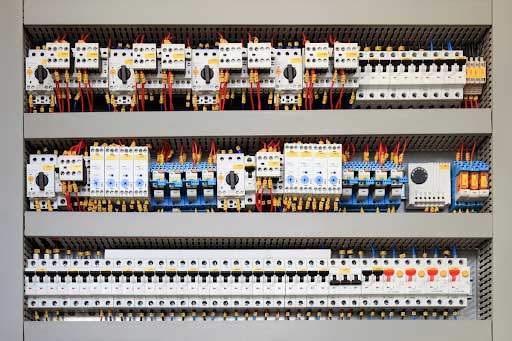Table of Contents:
- How Does An Electrical Panel Work?
- Symptoms of a Malfunctioning Electrical Panel
- Examining the Electrical Panel
- Why Should I Replace My Electric Panel?
How Does an Electrical Panel Work?
Your electric company’s main power line connects directly to a power meter outside your house, and the line is then connected to the electrical panel. The electrical panel in your home is normally located in a garage, utility room, closet or basement, and it’s usually gray.
There are rows of switches on the inside of the electrical panel. The circuit breakers are the devices that divide the main power line into smaller branch lines. Because they power machines which use a lot of electricity, including air conditioners and electric dryers, some of the switches are doubled or tripled. There should be a placard inside the electrical panel door that maps out the locations of the outlets and appliances based on the numbers on the switches. The switches also have numerals that indicate how many amps the branch line can handle before tripping the breaker switch. A main power breaker in the electrical panel can switch off power to the entire system.
Symptoms of a Malfunctioning Electrical Panel
Old electrical panels can fail; however, the issue is most often due to overloaded circuits. You may see flickering lights at first, or you may need to turn off one device to use another one that is hooked onto the same circuit. However, if the panel is dysfunctional or defective, the breakers will frequently trip (or fail to trip, resulting in a shock). In the worst-case scenario, a breaker that fails to trip can result in fire, smoke and melted wires.
Examining the Electrical Panel
Your electrical panel, especially if it’s older than 25 years, needs to be inspected regularly. Here are some indicators that you might require a new electrical panel:
- The electrical panel is making crackling noises, and the circuit breakers are corroded and rusted.
- The electrical panel’s interior is warm to the touch.
- Appliances are not operating at full capacity.
- GFCIs (ground fault circuit interrupters) are not available near water sources, such as sinks, tubs, dishwashers and clothes washers. If an appliance comes into contact with water, these outlets turn off the current, preventing electrocution.
- You’re continually plugging in things using extension cords.
- 60-amp electrical service is available in your home.
- Even if your home has a 100-amp electrical supply, some equipment will not work.
- A fuse block panel or a split-bus panel, which does not have a main breaker, is installed in your older home.
More for you:
- Your Step-by-Step Guide to Upgrading Your Home’s Electrical Panel
- Benefits And Importance Of Burnaby Electrical Panel Upgrades
Why Should I Replace My Electrical Panel?
Electrical panels should be replaced every 25-40 years as a rule of thumb, so if your house is that old, you’ll probably need to replace it. However, there are additional tell-tale signs that your current system is on its way out.
How Do I Know if I Need to Upgrade My Electrical Panel?
According to the Canadian Electrical Code, your residence’s minimum electrical service size is determined by kilowatt usage. This takes into account things like:
- The size of the floor
- Heating provided by electricity
- Air conditioning
- Units for charging vehicles
- Spas and hot tubs
A skilled electrician will be able to inform you whether your current and future electrical needs are being met, or whether you need to upgrade your electrical panel to 100 amps or 200 amps.
Panel upgrades enable your home to process more power and distribute it more effectively and efficiently throughout your home. You have various alternative courses of action when it comes to upgrading your electrical panel which include:
- Replacing the meter and circuit breaker with a higher-capacity unit
- Components that are outdated or damaged should be replaced
- Add circuits to your home so you can add more outlets
- To eliminate electrical hazards, replace circuits that are producing problems
- Circuits should be upgraded to suit modern electrical safety standards
Are you looking for an electrician that does electrical panel upgrades? Visit Gregg Electric or by call us at (604) 557-4734.




